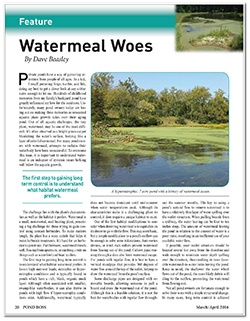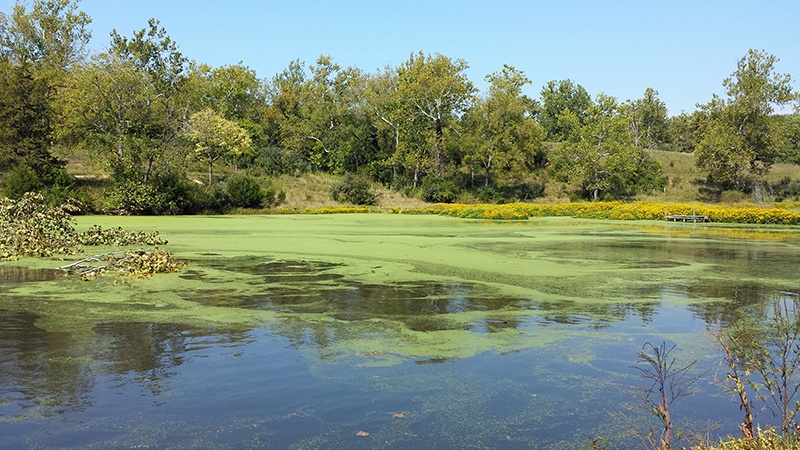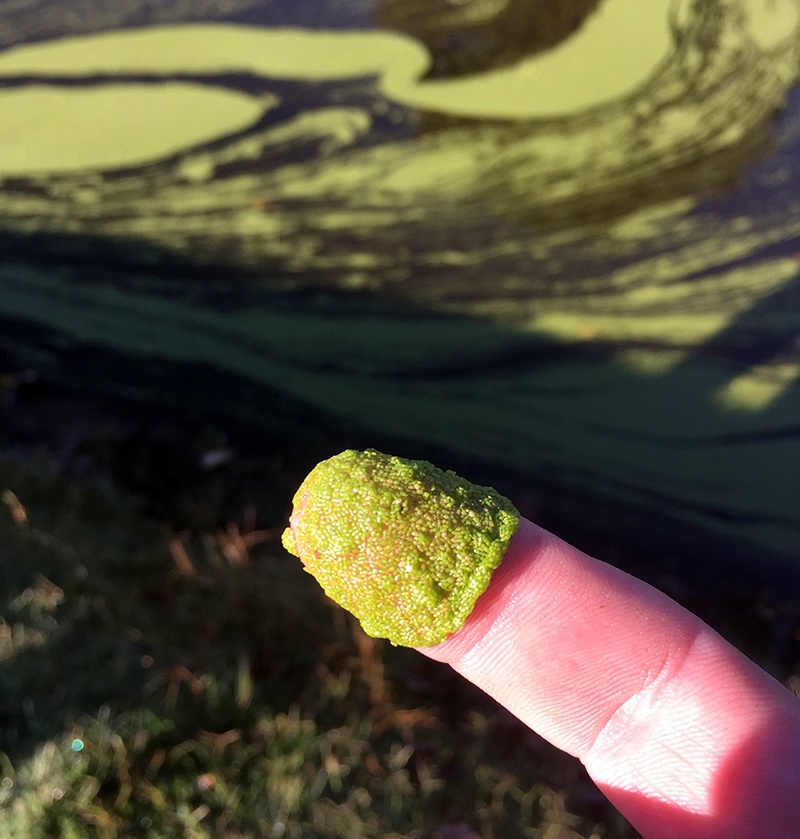AS SEEN IN Pond Boss Magazine, March/April 2016: Written by Industry Expert, David Beasley, Fisheries Biologist and Director of Fisheries
 Private ponds have a way of garnering attention from people of all ages. As a kid, I recall pestering frogs, turtles, and fish, doing my best to get a closer look at any critter naive enough to let me. Hundreds of childhood memories from my family’s backyard pond have greatly influenced my love for the outdoors. Unfortunately, many pond owners today are losing out on making these memories as unwanted aquatic plant growth takes over their aging pond. Out of all aquatic challenges, the tiny plant, watermeal, may be one of the most difficult. It’s often observed as a bright green carpet blanketing the water’s surface, looking like a layer of colorful cornmeal. For many pond owners with watermeal, attempts to reclaim their waterbody have been unsuccessful. To overcome this issue, it is important to understand watermeal is an indicator of systemic issues lurking well below the aquatic growth.
Private ponds have a way of garnering attention from people of all ages. As a kid, I recall pestering frogs, turtles, and fish, doing my best to get a closer look at any critter naive enough to let me. Hundreds of childhood memories from my family’s backyard pond have greatly influenced my love for the outdoors. Unfortunately, many pond owners today are losing out on making these memories as unwanted aquatic plant growth takes over their aging pond. Out of all aquatic challenges, the tiny plant, watermeal, may be one of the most difficult. It’s often observed as a bright green carpet blanketing the water’s surface, looking like a layer of colorful cornmeal. For many pond owners with watermeal, attempts to reclaim their waterbody have been unsuccessful. To overcome this issue, it is important to understand watermeal is an indicator of systemic issues lurking well below the aquatic growth.
The challenge lies with the plant’s characteristics as well as the habitat it prefers. Watermeal is a small, non-rooted, seed bearing plant, presenting a big challenge for those trying to gain control using contact herbicides. To make matters tough, the plant has a waxy cuticle that helps it resist herbicide treatments. It’s hard for an herbicide to penetrate. Furthermore, watermeal travels well, flowing from upstream, or catching a ride on things such as waterfowl and boat trailers.
The first step to gaining long term control is to understand what habitat watermeal prefers. It favors high nutrient loads, eutrophic or hyper-eutrophic conditions and is typically found in ponds which have a rich, black, organic muck layer. Although often associated with smaller, swamp-like waterbodies, it can also thrive in ponds with high flow if hyper-eutrophic conditions exist. Additionally, watermeal typically does not become dominant until mid-summer when water temperatures peak. Although its characteristics make it a challenging plant to control, it does require a unique habitat to exist.
One of the first habitat modifications to consider when deterring watermeal is to capitalize on its desire to go with the flow. This may seem basic, but a simple modification to a pond’s outflow can be enough to solve some infestations. Anti-vortex devices, or trash rack collars prevent watermeal from flowing out of the pond. Culvert pipes running through a dam also limit watermeal escape. For ponds with regular flow, it is best to have a vertical standpipe that provides 360 degrees of water flow around the top of the outlet, helping to draw the watermeal from the pond’s surface.
 Some discharge pipes are designed with removable boards, allowing someone to pull a board and draw the watermeal out of the pond. Although this is a feasible solution, it is not the best for waterbodies with regular flow throughout the summer months. The key to using a pond’s natural flow to remove watermeal is to have a relatively thin layer of water spilling over the outlet structure. When pulling boards from a spillway, the water leaving can be four to ten inches deep. The amount of watermeal leaving the pond in relation to the amount of water is a poor ratio, resulting in an inefficient use of your available water flow.
Some discharge pipes are designed with removable boards, allowing someone to pull a board and draw the watermeal out of the pond. Although this is a feasible solution, it is not the best for waterbodies with regular flow throughout the summer months. The key to using a pond’s natural flow to remove watermeal is to have a relatively thin layer of water spilling over the outlet structure. When pulling boards from a spillway, the water leaving can be four to ten inches deep. The amount of watermeal leaving the pond in relation to the amount of water is a poor ratio, resulting in an inefficient use of your available water flow.
If possible, your outlet structure should be located several feet away from the shoreline and wide enough to minimize water depth spilling over the structure, thus resulting in more favorable watermeal-to-water ratio leaving the pond. Keep in mind, the shallower the water which flows out of the pond, the more likely debris will cling to the outflow, preventing the watermeal from flowing out.
Not all pond owners are fortunate enough to solve their woes with a simple structural change. In many cases, long term control is achieved through an integrated approach. An ideal component to an integrated approach is promoting beneficial green algae as well as vegetation species such as water celery, water willow, pickerelweed, and duck potato. Since watermeal tends to be a mid/late season plant that thrives in heavy phosphorous environments, it is best to promote desirable algae and aquatic plants earlier in the season, limiting available nutrients to watermeal later in the year.
 Using plants and algae to redirect nutrients to a preferred outcome is great, but it is also important to reduce the ponds in-water phosphorous levels. This can be achieved using tools such as aeration, vegetative buffers, aluminum sulfate, and a unique lanthanum-modified clay (Phoslock). For those managing warm water fisheries, alum and Phoslock are not likely necessary and are typically only used once other options have been exhausted. For waterbodies with more than six feet of water, bottom diffused aeration is an ideal tool that should be incorporated as part of an integrated approach. Destratifying with aeration can reduce the amount of phosphorous that becomes available throughout the summer months. This reduction in phosphorous, teamed with promoting beneficial aquatic growth and a modified outflow structure, are an outstanding combination capable of manipulating habitat and discouraging watermeal.
Using plants and algae to redirect nutrients to a preferred outcome is great, but it is also important to reduce the ponds in-water phosphorous levels. This can be achieved using tools such as aeration, vegetative buffers, aluminum sulfate, and a unique lanthanum-modified clay (Phoslock). For those managing warm water fisheries, alum and Phoslock are not likely necessary and are typically only used once other options have been exhausted. For waterbodies with more than six feet of water, bottom diffused aeration is an ideal tool that should be incorporated as part of an integrated approach. Destratifying with aeration can reduce the amount of phosphorous that becomes available throughout the summer months. This reduction in phosphorous, teamed with promoting beneficial aquatic growth and a modified outflow structure, are an outstanding combination capable of manipulating habitat and discouraging watermeal.
Although many ponds with flow can have their issues solved following the above guidelines, ponds with little flow often require additional help from herbicides or tilapia. Treating with herbicides to gain control is an expensive option that can be short-lived. So, prior to running out and treating, it is best to formulate a strategy to make the pond’s habitat less appealing. Additionally, it is important to address all point-source issues upstream if feasible. If upstream ponds have watermeal, work with those land owners to solve your problems together. It is not efficient to treat ponds that have low water flow if watermeal will reenter the next time it rains.
When developing your integrated approach, keep in mind the herbicides used to eradicate watermeal are broad spectrum and will typically eradicate beneficial vegetation that you are trying to promote. For this reason, it is often best to treat with herbicides prior to promoting beneficial aquatic vegetation.
In states where they can legally be stocked, tilapia are a good alternative to herbicides. One down side to tilapia is they need to be restocked annually since they die in cooler weather. Another downside is they need to be stocked at aggressive rates if the pond is predator heavy. For this reason, tilapia work best in ponds with low numbers of predator fish. Like herbicides, tilapia are only addressing the symptom of the problem and are not addressing the watermeal’s habitat. For pond owners who find themselves in a tough situation dealing with a watermeal infestation, keep in mind that the watermeal is a product of its environment. Addressing the habitat should be the primary focus of your strategy and is best approached with a measure twice, cut once mentality. With the right understanding of the situation, the helpless feeling that your pond can not be reclaimed will likely be resolved.
Contact the experts at 888-480-5253 for all of your lake, pond and fisheries management needs.
David Beasley is a Fisheries Biologist and Director of Fisheries with SOLitude Lake Management. SOLitude Lake Management has been committed to providing full service lake and pond management services that improve water quality, preserve natural resources, and reduce our environmental footprint. Lake, pond and fisheries management services, consulting, and aquatic products are available nationwide. Learn more about SOLitude Lake Management and purchase products at www.solitudelakemanagement.com.










